|
|
|
Hypostomal Teeth
(non-type)
|
| ¤ |
Status dubious |
Guinea
- guineensis |
|
| ¤ |
Queen and male only
known (photographs on species page)
|
Zaïre -
neokohli |
|
| ¤ |
Minor only, description dubious |
Senegal - pallidelutea |
|
| . |
Adequately defined species |
-- |
|
| 1 |
 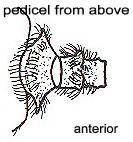 Major
postpetiole
wider than long; trapezoidal but variably dentate at widest point -
extremes shown right Major
postpetiole
wider than long; trapezoidal but variably dentate at widest point -
extremes shown right |
Section 2 |
|
| -- |
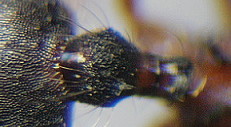 Major postpetiole not or hardly wider than long, only
rounded or
slightly angled at sides; minors also with small spherical postpetioles Major postpetiole not or hardly wider than long, only
rounded or
slightly angled at sides; minors also with small spherical postpetioles
|
2 |
|
| . |
rugaticeps-group - concinna, rugaticeps,
tenuinodis & victoris |
-- |
|
| 2 |
Major occiput with transverse
striation; minors with long scapes, SI ca 160 or more
|
3 |
|
| -- |
Major occiput near smooth and shining; minors with shorter scapes, SI max. 140
|
4 |
|
| 3 |

TL
ca 5.6 mm, HL 1.97, HW 1.87, SL 1.1, PW 0.84; CI 93, SI 58; postpetiole
about twice as long as wide and with a moderate,
rounded, lateral angle; head with very fine puncturation/shagreening
(much finer than rugaticeps), background of underlying
longitudinal striation which becomes oblique posterior to the eyes
angling outwards to occipital corners; erect pilosity yellowish, long
and quite abundant all over, longer and denser on the head than in rugaticeps;
colour alitrunk dark red; head, funiculus & mandible lighter;
border of mandibles, anterior of clypeus, scapes, summit of pedicel
nodes and gaster blackish; femora brown, tibiae and tarsi yellowish
brown |
. |
|
| . |
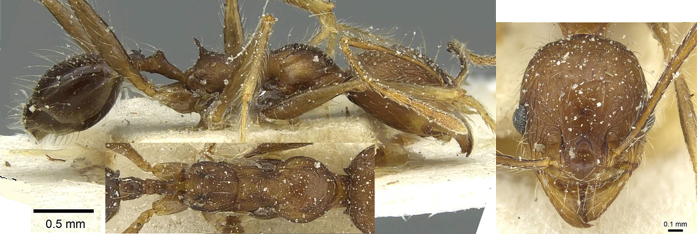
TL
3.5-4.3 mm, HL 1.09, HW 0.91, SL , PW 0.62; CI 82, SI 157; head
narrower than long, frontal area wide
and very distinctly impressed, occiput rounded and narrowed; clypeus
often weakly carinate; mandibles with two apical teeth and 5-6
denticles; mandibles very finely striate; scape surpasses occiput by
more than a quarter of its length; alitrunk impressed between the
pronotum and mesonotum, with transverse welt; metanotal groove deep,
spines slightly longer than one-third the propodeal dorsum; legs long;
petiole narrow and elongate, postpetiole about one-third longer than
wide; rest of head smooth and shiny other than irregular longitudinal
rugae on the sides; alitrunk and pedicel densely punctate but less so
on the pronotum dorsum and pedicel which are shiny; lateral propodeum
striate; erect pilosity abundant and long, yellowish; longer and denser
on the head than on rugaticeps; gaster and legs smooth; dull red with
head the same colour as the alitrunk |
Congo -
concinna |
|
| -- |

TL 5-6.5 mm, HL 2.2,
HW 2.0, SL 1.10, PW 0.8; CI 91, SI 55;
postpetiole scarcely wider than
long, with a moderate, rounded, lateral angle; sides of head striate to
occiput in a straight longitudinal manner; ferruginous, gaster fuscous |
. |
 |
| . |
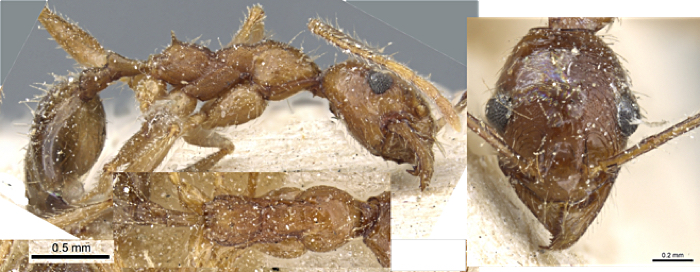
TL
3-3.5 mm, HL 0.84, HW 0.65, SL 1.67, PW 0.46; CI, SI ; CI 76, SI
177-180; head elongated, clypeus without a carina;
propodeal spines short, oblique & divergent; postpetiole wider than
petiole, subconical; head smooth other than lateral rugae; alitrunk
finely coriaceous; all over with numerous erect hairs;
ferruginous-testaceous, gaster darker |
Sahel zone - rugaticeps |
|
| -- |
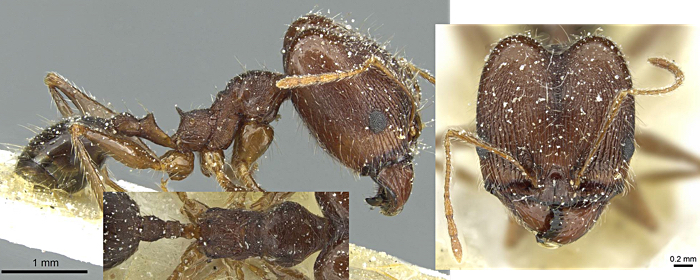
TL
5.3-5.5 mm, HL 1.86, HW 1.66, SL 1.00, PW 0.80; CI 88, SI 60; head matt
with occipitum shiny, regular striation, longitudinal in
anterior two-thirds, becoming finer and converging towards occiput
where they are transverse; overall quite heavily sculptured, pedicael
and gaster with dense fine spiculation; overall dark brown, gaster
blackish
Hypostoma of major with no teeth or solely a minute pair of submedian
teeth; from underneath mandibles distinctively margined with the area
between impressed |
. |
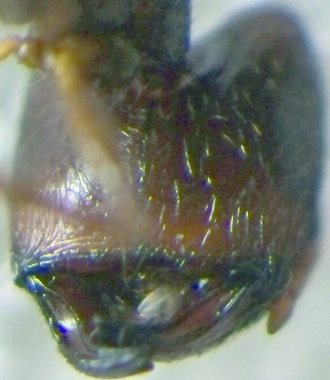 |
|
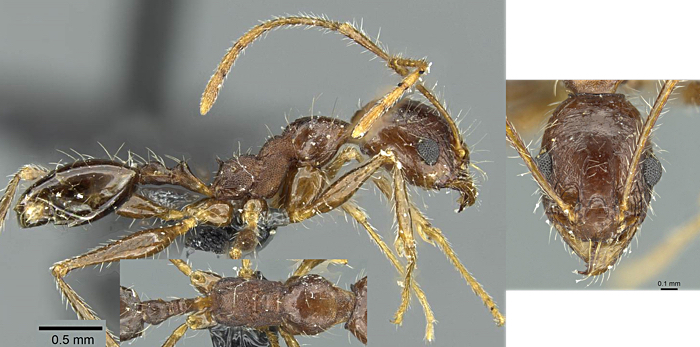
TL
3.5 mm, HL 0.75, HW 0.50, SL 1.00, PW 0.40; CI 80, SI 180; eyes
unusually large; head oval
less than twice as long as wide
when the eyes are ignored; occipital border with nuchal collar (?);
clypeus smooth weakly convex with a short median carina; frontal
carinae about one fifth longer than they are apart; frontal notch weak
and short; alitrunk fairly elongate, mesonotum profile convex,
propodeal spines upright, fairly divergent and about as long as
three-quarters their basal interval; petiole with a long pedicel,
summit entire; postpetiole about one quarter longer than posterior
width, laterally obtusely angled; most of head smooth and shiny, sides
reticulo-punctate; alitrunk & pedicel regularly reticulo-punctate,
reduced on pronotum dorsum; gaster smooth other than a few basal
reticulations; dark brown, alitrunk sometimes dorsally lighter,
appendages brown, articulations and tarsi yellow brown |
Sahel
zone - andrieui |
|
| . |
Head smooth and shiny |
-- |
|
| 4 |
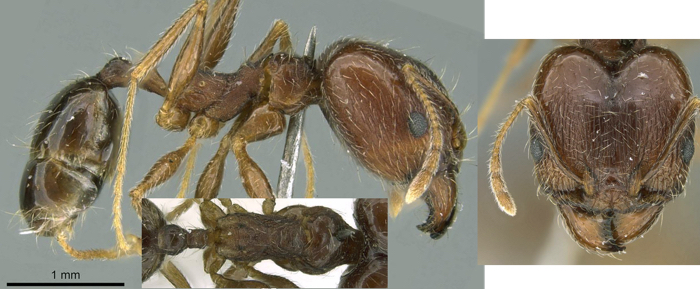
TL 4.5 mm, HL 1.18, HW 1.18, SL 0.72, PW 0.50; CI 100,
SI 61; anterior
three-fifths of head, strongly and longitudinally striate; colour of
head and alitrunk dark yellowish-red, propodeal spines and lateral
propodeum dark brown, gaster brown but basally paler; postpetiole
subglobose, feebly convexly angled laterally, narrowed behind, 75%
wider than petiole and about as long as wide
|
. |
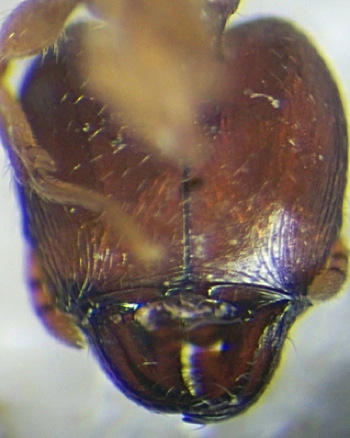
|
| . |

TL
2.8-3.2 mm, HL 0.86, HW 0.61, SL 0.88, PW 0.85; CI 83, SI 126-140; head
wider behind than in front, anterior
margin of clypeus shallowly emarginate, median area with a raised line;
funiculus with first segment as long as next two together; propodeum
dorsum weakly marginate; pilosity long and abundant; colour similar to
punctulata but head and alitrunk darker and more reddish-brown - seems
variable but may include more than one species
|
Pan
African savannah - tenuinodis |
|
| -- |
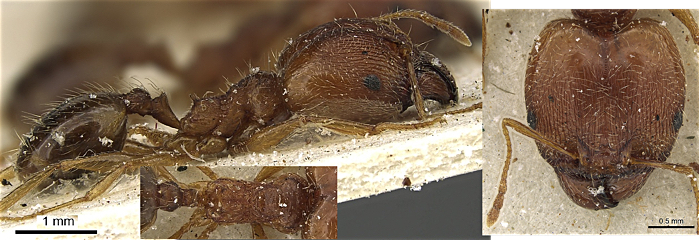
TL ca 5.6 mm, HL 1.75, HW 1.75, SL 0.86, PW 0.7, CI 100, SI 50.
Larger with shallower impression to occiput
|
. |
|
| . |

TL ca 3.10 mm, HL 0.78, HW 0.68, SL 0.86, PW 0.48, CI 87, SI 127.
Head more elongated
|
Zimbabwe - sipapomae |
|
| -- |
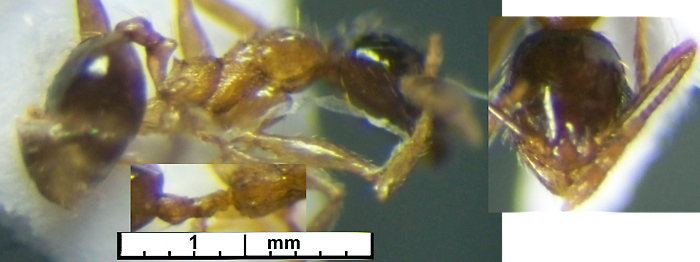
Minor only known; TL ca 3.5 mm, HL 0.58, HW
0.47, SL 0.57, PW 0.33; CI 86, SI 115; postpetiole small and
globular; bicoloured with head and gaster contrasting with the
orange-brown alitrunk
|
Benin -
RVA
2900 |
|
| -- |
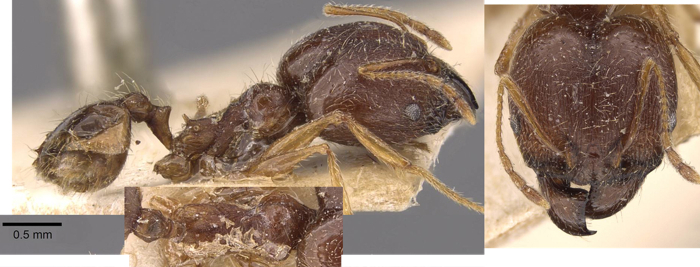
TL 4.2 mm, HL 1.44, HW 1.44, SL 0.87, PW 0.48; CI 100,
SI 60; postpetiole almost twice as
wide as petiole, about 25% wider than long, sides obtusely angled at
the widest mid-point; head dull except posterior quarter which is
microscopically rugulose and slightly shining; colour very similar to tenuinodis |
. |
|
| . |
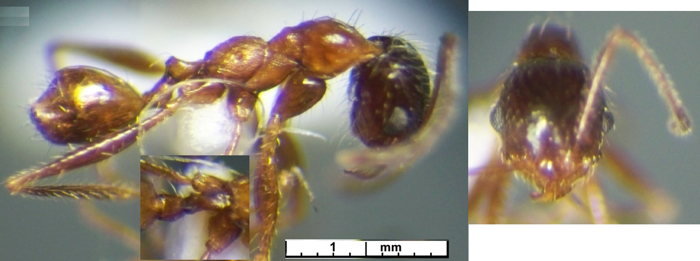
TL
(2.3) 3.5 mm (fresh minor, shown), HL 0.75, HW 0.64, SL 0.82, PW 0.35;
CI 88, SI 132; head
more rounded widest in the middle, eyes very convex placed at
mid-point; propodeal spines quite small; propodeum declivity oblique
shorter than dorsum; head sides finely reticulate-punctate and with
longitudinal striae which do not extend back beyond the eyes;
reddish-yellow, head darker behind, gaster brown, paler at base |
Namibia & Zimbabwe - victoris |
|
|
 Top of page Top of page
|
|
|
|